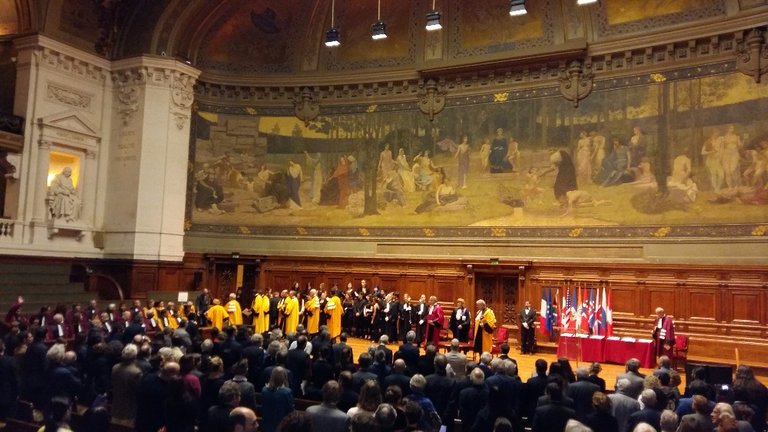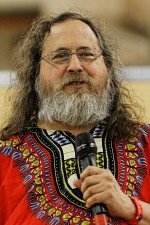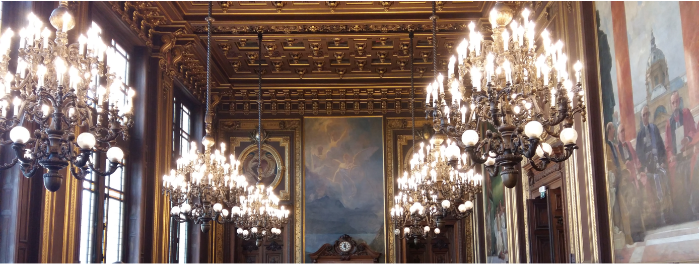Last Tuesday, the university at which I work (the Pierre and Marie Curie University in Paris) and the Sorbonne University (which will soon merge with the Pierre and Marie Curie University) have jointly honored six women and eight men from all continents by granting them honorary doctorate degrees.
SOME WORDS ON THE CEREMONY
The ceremony has been held in the Grand Amphitheater of the Sorbonne University, in the presence of politics, the heads of the university and a selected set of (local and external) scientific personalities.
This room is the most prestigious room of the Sorbonne, with statues of Descartes, de Sorbon, Archimedes, Lavoisier and probably others that I have not noticed, as well as a huge painting (25.6 meter long and 4.5 meters height) named The Sacred Wood and created by Puvis de Chavannes. This painting evokes science, arts and literature and can be partially seen here:

The picture of the room above has been taken with my cell phone (which is all what I had with me last Tuesday). One can notice, additionally to the painting, the statue of Robert de Sorbon on the left.
This post discusses honorary degree nominees, and they are also visible on the picture. The ‘yellow guys’ are the nominees (and the associated promoters) in Arts and Literature and the ‘red guys’ (less visible, on the left-lower part of the picture) are those in Science and Medicine.
SOME WORDS ON THE 2016 NOMINEES
An honoris causa (or honorary) doctorate degree is a distinction offered to a person who is external to an university as a reward for his or her contribution for improving our society.
All the 14 people rewarded this year have of course excellent records, but they have also committed themselves to serve the common good. During the ceremony, I have heard a few key points about their personal life and achievements, as well as nice musical intermezzos (again sorry for the low quality of the picture… I will definitely not tag this post as photography) :)

The aim of this post is not to review the curriculum of all the 14 nominees, as the information can be found on the official page of the UPMC. I instead only emphasize, with one single sentence to underline the variety of the domains covered this year: mathematics, theoretical physics, medicine, linguistics, climate changes, marine biodiversity, etc. One can note that the first female Prime Minister of Norway was among the nominees, as well as a former president of Iceland.
HONORING SOFTWARE FREEDOM
There is however one guy I would like to discuss in this post, Richard Stallman. His name is very well known in the scientific community (and maybe also in the world) as he is the founder of the GNU project, and also the initiator and strongest bearer of the movement for software freedom.
 [image credits: wikipedia]
[image credits: wikipedia]
Richard Stellman was first an engineer working on Artificial Intelligence at the MIT, and then started the GNU (a funny recursive acronym for GNU is Not Unix) project in the eighties. He is since then strongly promoting free software, that by the way also respects the freedom of the user.
I guess that everybody on Steemit is convinced by the needs of having software freedom. Let me briefly recall some of the numerous benefits.
- One has access to the software source code, which gives the opportunity to study how a given program works.
- One can use the software for anything and anywhere.
- One can improve it, add new modules, or equivalently broadening its scope.
- A free software is easy to share, distribute (including potential modified versions so that everybody can benefit from the improvements).
And to support free software, we need a full development infrastructure! Does this remember us anything by any chance?
Richard Stallman has also developed the concept of copyleft that is connected to the GPL (GNU Public License). This ensures users the right to use a code, study it, share it and modify it. And who thinks to GNU also thinks to Linux of course, an operating system now used by more than 10 million people.
A PERSONAL FEELING AS A CONCLUSION
I am today proud to be part of a university recognizing the importance of free software. I am personally in charge of the development of several codes widely used by the particle physics community, and they are all under the GPL license, free to use / modify / share.
One picture of the ceiling of one of the surrounding rooms to finish with:

This building is so nice… ;)
Nice to see these people being honored for their contributions to furthering the usefulness of technology of technology :)
Sometimes there is a reward for doing something for free. An honorary doctoral degree is quite the honor!
I'd say that it's often the case when the personal reward/satisfaction is higher if money is not involved...
We are definitely on the same page :)
Interesting to know that technology is recognized
Wow.
Upvoted and following.
Wow! Great! Nice to know that you were there!!...and the building is really awe inspiring!
Best,
M. Medro